古印度文化【英文】 Great Ancient Indians
介绍印度历史和文化小学英语五年级作文
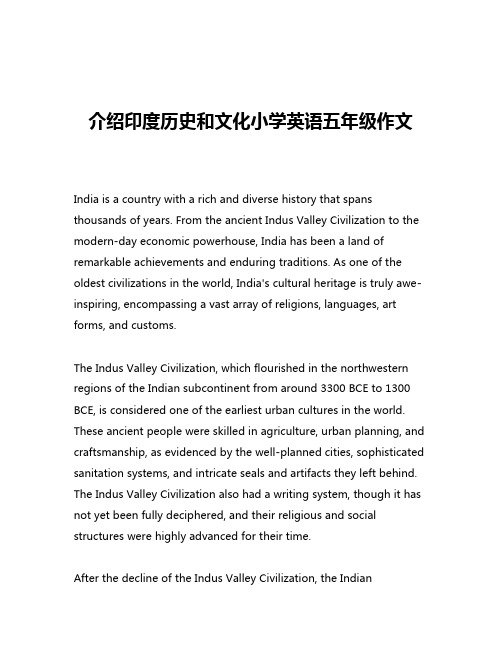
介绍印度历史和文化小学英语五年级作文India is a country with a rich and diverse history that spans thousands of years. From the ancient Indus Valley Civilization to the modern-day economic powerhouse, India has been a land of remarkable achievements and enduring traditions. As one of the oldest civilizations in the world, India's cultural heritage is truly awe-inspiring, encompassing a vast array of religions, languages, art forms, and customs.The Indus Valley Civilization, which flourished in the northwestern regions of the Indian subcontinent from around 3300 BCE to 1300 BCE, is considered one of the earliest urban cultures in the world. These ancient people were skilled in agriculture, urban planning, and craftsmanship, as evidenced by the well-planned cities, sophisticated sanitation systems, and intricate seals and artifacts they left behind. The Indus Valley Civilization also had a writing system, though it has not yet been fully deciphered, and their religious and social structures were highly advanced for their time.After the decline of the Indus Valley Civilization, the Indiansubcontinent saw the rise of various kingdoms and empires, each leaving its mark on the country's cultural and political landscape. The Maurya Empire, which ruled over much of the Indian subcontinent in the 3rd century BCE, was a particularly significant period in Indian history. Under the reign of the famous emperor Ashoka, the Maurya Empire embraced Buddhism and spread its teachings throughout the region and beyond. Ashoka's rock edicts, which contain his moral and religious teachings, are some of the earliest examples of written language in India and have had a lasting impact on the country's cultural identity.The subsequent centuries saw the rise and fall of numerous dynasties, including the Gupta Empire, the Delhi Sultanate, and the Mughal Empire. Each of these empires brought with them unique cultural influences, from the Sanskrit literature and classical arts of the Gupta period to the magnificent Mughal architecture and the introduction of the Urdu language. The Mughal Empire, in particular, left an indelible mark on India, with its grand palaces, intricate gardens, and the iconic Taj Mahal, one of the most recognizable landmarks in the world.Despite the many foreign invasions and conquests, India has maintained a remarkable resilience and continuity in its cultural traditions. The country's diverse religious landscape, which includes Hinduism, Buddhism, Sikhism, Islam, and Christianity, among others,has been a defining feature of Indian culture for centuries. Each of these religions has contributed to the rich tapestry of Indian art, music, literature, and architecture, creating a truly syncretic and harmonious cultural heritage.One of the most striking aspects of Indian culture is its linguistic diversity. India is home to over 19,500 dialects and 22 officially recognized languages, including the ancient Sanskrit and the widely spoken Hindi and English. This linguistic diversity is a testament to the country's long history of cultural exchange and the ability of its people to adapt and integrate new influences into their own traditions.Indian art and architecture are equally diverse and captivating. From the intricate rock-cut temples of Ellora and Ajanta to the grand Mughal palaces and the colorful, vibrant street art found in cities across the country, Indian art reflects the country's rich cultural heritage and the creativity of its people. Indian music and dance, too, are deeply rooted in ancient traditions and have evolved over centuries, with styles ranging from the classical Carnatic and Hindustani music to the lively folk dances of different regions.In the realm of literature, India has produced some of the world's most influential and celebrated writers, from the ancient Sanskrit epics of the Mahabharata and the Ramayana to the modern-daymasterpieces of Rabindranath Tagore, Salman Rushdie, and Arundhati Roy. Indian literature reflects the country's diverse cultural influences and the rich tapestry of its linguistic heritage.Beyond its cultural achievements, India is also known for its rich biodiversity and natural wonders. From the snow-capped Himalayas in the north to the tropical rainforests of the south, India is home to a vast array of flora and fauna, including the iconic Bengal tiger, the Asian elephant, and the one-horned rhinoceros. The country's diverse landscapes, from the arid deserts of Rajasthan to the lush backwaters of Kerala, offer endless opportunities for exploration and adventure.Today, India stands as a global economic and technological powerhouse, with a rapidly growing economy and a thriving tech industry. However, the country has also faced its share of challenges, from poverty and inequality to environmental degradation and political instability. Despite these challenges, India's resilience and its ability to adapt and evolve have been a testament to the strength and ingenuity of its people.In conclusion, India's history and culture are truly awe-inspiring, reflecting the country's remarkable diversity, resilience, and enduring spirit. From its ancient civilizations to its modern-day achievements, India's rich cultural heritage continues to captivate and inspirepeople around the world. As a country that has weathered countless challenges and invasions, India's story is one of resilience, creativity, and the enduring power of human ingenuity.。
关于印度文化的英语作文

India: A Melting Pot of Rich Culture andTraditionsIndia, a land of diverse cultures and traditions, is renowned for its rich heritage that spans thousands of years. From the ancient Vedic civilization to the medieval Mughal era and modern India, this subcontinent has witnessed a blend of various cultures, religions, and languages, giving rise to a unique and vibrant cultural mosaic.At the core of Indian culture lies the ancient Vedic philosophy, which emphasizes harmony with nature, the pursuit of knowledge, and the importance of morality and ethics. This philosophy has influenced Indian art, music, dance, and literature, shaping them into expressions that are deeply rooted in tradition yet continuously evolving. The diversity of Indian culture is evident in its festivals and celebrations. Each festival is a vibrant display of color, music, and dance, reflecting the spirit of joy and unity among people. Diwali, the festival of lights, is celebrated with the lighting of lamps and fireworks, symbolizing the victory of good over evil. Holi,the festival of colors, is a celebration of love and brotherhood, where people throw colored powder and water at each other. These festivals not only bring people together but also promote the values of unity and inclusivity that are integral to Indian culture.India's art and architecture are also reflections ofits rich cultural heritage. From the intricate carvings of temples in South India to the majestic forts and palaces of the Mughal era, Indian artisans have left a lasting impression on the world. Indian painting, sculpture, and pottery are also renowned for their unique styles and techniques.Moreover, Indian cuisine is another aspect of its culture that has gained global recognition. With a vast array of spices, herbs, and cooking techniques, Indian food is not only delicious but also a testament to thecreativity and innovation of Indian chefs. Each region in India has its unique culinary traditions, ranging from the spicy curries of the South to the richer, creamier dishes of the North.In conclusion, India's culture is a dynamic andevolving entity that continues to inspire and enchantpeople from all over the world. It is a tapestry of traditions, values, and practices that have been passed down through generations, shaping the identity andcharacter of this ancient civilization. As India moves forward into the future, its rich cultural heritage remains a source of pride and inspiration for its people.**印度:文化与传统交融的熔炉**印度,这片文化与传统交织的土地,因其跨越数千年的丰富遗产而闻名于世。
四年级英语古代文明成就单选题40题

四年级英语古代文明成就单选题40题1.The Great Pyramid is very ______.A.tallB.shortC.smallD.thin答案:A。
The Great Pyramid(金字塔)是非常高大的,tall 表示高,short 表示矮,small 表示小,thin 表示瘦。
金字塔很庞大且高,所以选tall。
这里考查了描述建筑的形容词。
2.The Temple of Artemis is famous for its ______.A.beautyB.strengthC.heightD.width答案:A。
The Temple of Artemis( 阿尔忒弥斯神庙)以美丽著称,beauty 表示美丽,strength 表示力量,height 表示高度,width 表示宽度。
阿尔忒弥斯神庙以其美丽闻名,所以选beauty。
考查了描述建筑的名词。
3.The Colosseum is a place for ______.A.playsB.meetingsC.fightsD.studies答案:C。
The Colosseum( 罗马斗兽场)是一个进行格斗的地方,fights 表示格斗,plays 表示戏剧,meetings 表示会议,studies 表示学习。
罗马斗兽场是进行角斗等活动的场所,所以选fights。
考查了建筑的用途。
4.The Parthenon is made of ______.A.woodB.stoneC.clayD.paper答案:B。
The Parthenon 帕特农神庙)是由石头建造的,stone 表示石头,wood 表示木头,clay 表示黏土,paper 表示纸。
帕特农神庙是石质建筑,所以选stone。
考查了建筑的材料。
5.The Hanging Gardens of Babylon are known for their ______.A.colorsB.flowersC.treesD.beauty答案:D。
四年级英语古代文明成就单选题40题

四年级英语古代文明成就单选题40题1. The Great Pyramid in Egypt is very famous. It is a great _____.A. buildingB. paintingC. songD. story答案:A。
解析:金字塔是一种建筑,选项A“building”(建筑)符合金字塔的属性。
选项B“painting”(绘画),金字塔不是绘画。
选项C“song”(歌曲),与金字塔毫无关联。
选项D“story”(故事),虽然有关于金字塔的故事,但金字塔本身不是故事。
2. Ancient Egyptians used _____ to write.A. alphabet lettersB. hieroglyphsC. numbersD. pictures答案:B。
解析:古埃及人使用象形文字((hieroglyphs)书写,这是古埃及文明的重要成就。
选项A“alphabet letters”((字母)不是古埃及人书写的方式。
选项C“numbers”((数字),单独的数字不是古埃及主要的书写形式。
选项D“pictures”((普通的图片)不准确,古埃及用的是特定的象形文字而不是普通图片。
3. The pyramids were built as _____.A. housesB. tombsC. templesD. markets答案:B。
解析:金字塔是被建造为陵墓((tombs)的,这是金字塔的主要用途。
选项A“houses”((房子),金字塔不是普通居住的房子。
选项C“temples”((庙宇),金字塔不是庙宇。
选项D“markets”((市场),与金字塔的用途完全不同。
4. Which one is a famous ancient Egyptian symbol?A. The crossB. The ankhC. The starD. The heart答案:B。
ancient indian text 古印度文献
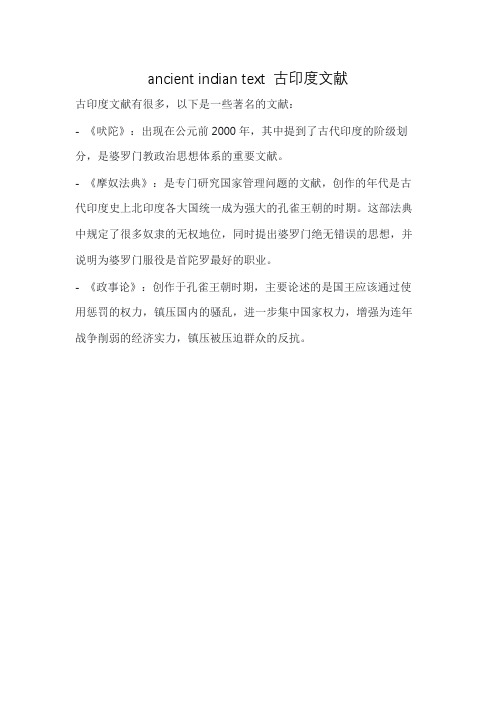
ancient indian text 古印度文献
古印度文献有很多,以下是一些著名的文献:
- 《吠陀》:出现在公元前2000年,其中提到了古代印度的阶级划分,是婆罗门教政治思想体系的重要文献。
- 《摩奴法典》:是专门研究国家管理问题的文献,创作的年代是古代印度史上北印度各大国统一成为强大的孔雀王朝的时期。
这部法典中规定了很多奴隶的无权地位,同时提出婆罗门绝无错误的思想,并说明为婆罗门服役是首陀罗最好的职业。
- 《政事论》:创作于孔雀王朝时期,主要论述的是国王应该通过使用惩罚的权力,镇压国内的骚乱,进一步集中国家权力,增强为连年战争削弱的经济实力,镇压被压迫群众的反抗。
四年级英语古代文明成就单选题40题
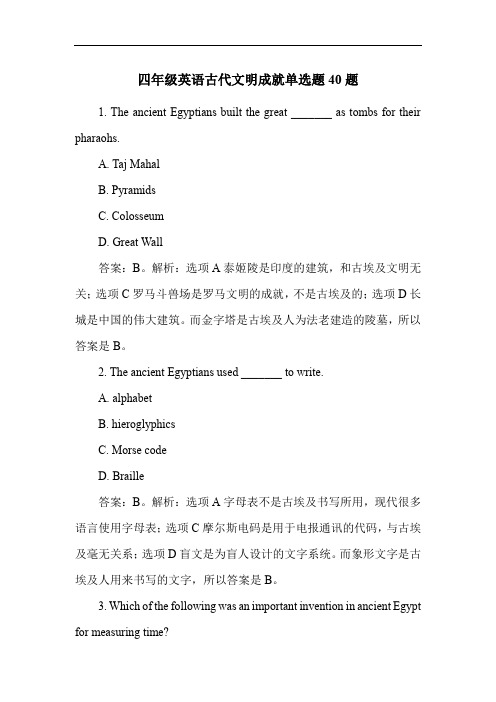
四年级英语古代文明成就单选题40题1. The ancient Egyptians built the great _______ as tombs for their pharaohs.A. Taj MahalB. PyramidsC. ColosseumD. Great Wall答案:B。
解析:选项A泰姬陵是印度的建筑,和古埃及文明无关;选项C罗马斗兽场是罗马文明的成就,不是古埃及的;选项D长城是中国的伟大建筑。
而金字塔是古埃及人为法老建造的陵墓,所以答案是B。
2. The ancient Egyptians used _______ to write.A. alphabetB. hieroglyphicsC. Morse codeD. Braille答案:B。
解析:选项A字母表不是古埃及书写所用,现代很多语言使用字母表;选项C摩尔斯电码是用于电报通讯的代码,与古埃及毫无关系;选项D盲文是为盲人设计的文字系统。
而象形文字是古埃及人用来书写的文字,所以答案是B。
3. Which of the following was an important invention in ancient Egypt for measuring time?A. SundialB. HourglassC. Atomic clockD. Water clock答案:A。
解析:选项B沙漏不是古埃及用于测量时间的重要发明;选项C原子钟是现代高科技产物;选项D水钟虽然古埃及有,但相比之下,日晷是古埃及非常重要的测量时间的发明,所以答案是A。
4. The ancient Egyptians were good at making _______ which was used to preserve the dead bodies.A. mummiesB. statuesC. potteryD. jewelry答案:A。
解析:选项B雕像不是用于保存尸体的;选项C陶器主要用于日常生活等用途;选项D珠宝是装饰品。
介绍印度历史和文化小学英语五年级作文

介绍印度历史和文化小学英语五年级作文Title: The Rich History and Culture of IndiaIndia, a country with a history that spans thousands of years, is a fascinating land filled with diverse cultures, religions, and traditions. From the ancient Indus Valley Civilization to the modern Indian nation, India's history is a tapestry of incredible stories and achievements.Long ago, around 2600 BCE, the Indus Valley Civilization was one of the world's first urban civilizations. It was known for its advanced town planning with well-laid-out streets and a sophisticated drainage system. This civilization was a testament to the early engineering skills of the people of the region.In the ancient times, India was home to great empires like the Maurya and Gupta dynasties. The Mauryan Empire, especially under the rule of Emperor Ashoka, was famous for its spread of Buddhism. The Gupta Empire, often referred to as the "Golden Age" of India, saw great advancements in science, art, and literature.India's history is also marked by its struggles against colonial rule. The British East India Company arrived in the 17th century and gradually took control of the Indian subcontinent. The infamous Revolt of 1857, also known as the First War ofIndian Independence, was a significant resistance against British rule. Finally, in 1947, India gained independence from British rule, led by leaders like Mahatma Gandhi.The culture of India is as diverse as its history. India is known as the land of festivals, with each region having its own unique celebrations like Diwali, Holi, and Dussehra. These festivals are a vibrant display of the country's religious and cultural heritage.Indian cuisine is famous worldwide for its variety and flavors. From the spicy curries of the south to the sweet desserts of the north, Indian food is a feast for the senses. The traditional attire, such as the sari for women and the dhoti for men, reflects the rich textile tradition of the country.India's contribution to the arts is significant. The country has a long tradition of classical music and dance, with styles like Bharatanatyam, Kathak, and Carnatic music being renowned globally. Indian literature also boasts of ancient epics like the Mahabharata and the Ramayana.In conclusion, India's history and culture are a treasure trove of knowledge and beauty. It is a country that has influenced the world in countless ways and continues to do so with its rich heritage.中文翻译:标题:印度丰富的历史和文化印度,一个拥有数千年历史的国家,是一个充满多样文化、宗教和传统的迷人土地。
三年级古代文明英语阅读理解25题
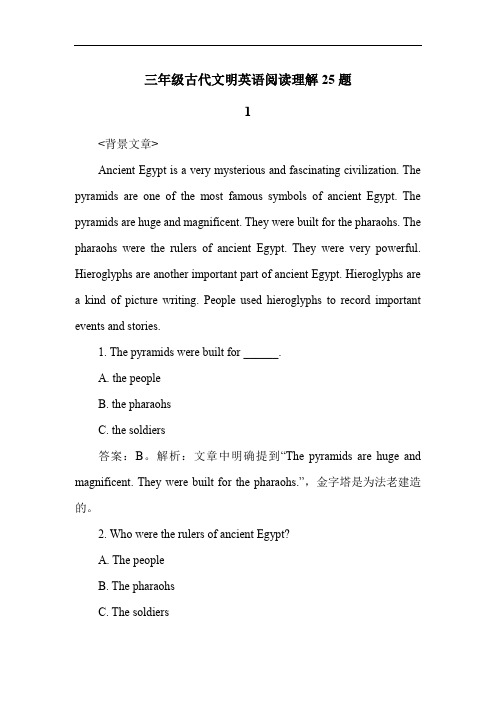
三年级古代文明英语阅读理解25题1<背景文章>Ancient Egypt is a very mysterious and fascinating civilization. The pyramids are one of the most famous symbols of ancient Egypt. The pyramids are huge and magnificent. They were built for the pharaohs. The pharaohs were the rulers of ancient Egypt. They were very powerful. Hieroglyphs are another important part of ancient Egypt. Hieroglyphs are a kind of picture writing. People used hieroglyphs to record important events and stories.1. The pyramids were built for ______.A. the peopleB. the pharaohsC. the soldiers答案:B。
解析:文章中明确提到“The pyramids are huge and magnificent. They were built for the pharaohs.”,金字塔是为法老建造的。
2. Who were the rulers of ancient Egypt?A. The peopleB. The pharaohsC. The soldiers答案:B。
解析:文中提到“The pharaohs were the rulers of ancient Egypt.”,法老是古埃及的统治者。
3. Hieroglyphs are a kind of ______.A. picture writingB. letter writingC. number writing答案:A。
初一英语古代文明单选题30题
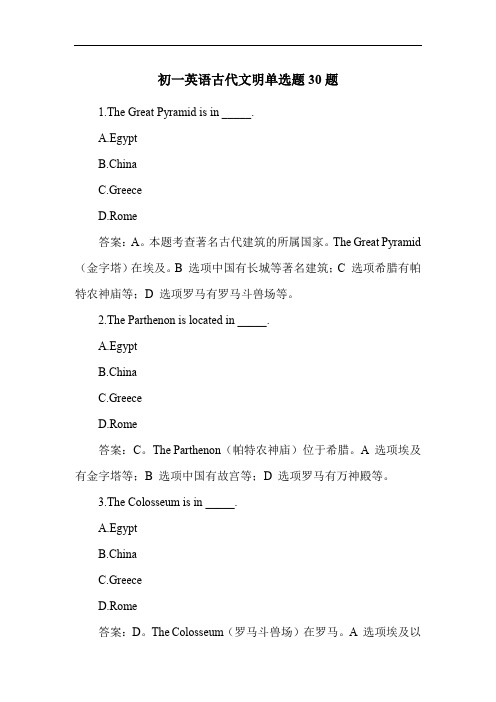
初一英语古代文明单选题30题1.The Great Pyramid is in _____.A.EgyptB.ChinaC.GreeceD.Rome答案:A。
本题考查著名古代建筑的所属国家。
The Great Pyramid (金字塔)在埃及。
B 选项中国有长城等著名建筑;C 选项希腊有帕特农神庙等;D 选项罗马有罗马斗兽场等。
2.The Parthenon is located in _____.A.EgyptB.ChinaC.GreeceD.Rome答案:C。
The Parthenon(帕特农神庙)位于希腊。
A 选项埃及有金字塔等;B 选项中国有故宫等;D 选项罗马有万神殿等。
3.The Colosseum is in _____.A.EgyptB.ChinaC.GreeceD.Rome答案:D。
The Colosseum((罗马斗兽场)在罗马。
A 选项埃及以金字塔闻名;B 选项中国有很多古老建筑如兵马俑等;C 选项希腊的代表建筑是帕特农神庙。
4.The Terracotta Army is in _____.A.EgyptB.ChinaC.GreeceD.Rome答案:B。
The Terracotta Army((兵马俑)在中国。
A 选项埃及有金字塔等;C 选项希腊有帕特农神庙等;D 选项罗马有罗马斗兽场等。
5.The Temple of Artemis is in _____.A.EgyptB.ChinaC.GreeceD.Rome答案:C。
The Temple of Artemis(阿尔忒弥斯神庙)位于希腊。
A 选项埃及有著名的金字塔等;B 选项中国有长城、兵马俑等;D 选项罗马有罗马斗兽场等。
6.The ancient Egyptians invented _____.passB.paperC.pyramidD.gun答案:C。
古埃及人发明了金字塔。
选项 A 指南针是中国古代发明的;选项B 纸是中国古代发明的;选项D 枪不是古代发明的。
关于印度文化的英语作文

关于印度文化的英语作文India, a country of diverse cultures and traditions, has a rich and vibrant history that has been shaped by centuries of social, political, and religious evolution. This essay aims to explore the various facets of Indian culture, including its festivals, cuisine, attire, and the influence of its ancient philosophies on the modern world.Festivals: The Celebration of LifeOne of the most striking aspects of Indian culture is its multitude of festivals. These celebrations are not just religious occasions but are also a time for families and communities to come together. Diwali, the festival of lights, is perhaps the most well-known, symbolizing the victory of light over darkness and good over evil. It is marked by the lighting of oil lamps and the bursting of fireworks. Other significant festivals include Holi, the festival of colors, where people throw colored powders at each other; Eid, a celebration marking the end of Ramadan; and Navaratri, anine-night festival dedicated to the goddess Durga.Cuisine: A Melting Pot of FlavorsIndian cuisine is as diverse as its culture, with each region offering its own unique dishes and flavors. The use of spices is a common thread that runs through Indian cooking, with each spice having its own medicinal properties andenhancing the taste of the dish. North Indian cuisine is known for its tandoori dishes and rich gravies, while South Indian food is characterized by its use of rice and coconut. The diversity in Indian food is also evident in its vegetarian options, which are plentiful and delicious, reflecting the largely vegetarian population.Attire: A Sartorial SymphonyThe traditional attire of India is a reflection of its cultural heritage. For men, the dhoti and kurta are common in the north, while the lungi and veshti are worn in the south. Women's clothing varies from the saree, a long strip of cloth elegantly draped around the body, to the salwar kameez, a combination of a long shirt and loose trousers. The use of vibrant colors and intricate embroidery is a testament to the craftsmanship and artistry that goes into creating these garments.Philosophy and Spirituality: The Bedrock of Indian CultureIndia is the birthplace of several major world religions, including Hinduism, Buddhism, Jainism, and Sikhism. The teachings of these religions have had a profound impact on Indian culture, promoting values such as non-violence, compassion, and tolerance. Yoga and meditation, which originated in India, have become popular worldwide as methods for achieving mental and physical well-being.Influence on the Modern WorldThe influence of Indian culture extends beyond its borders. Bollywood, the Indian film industry, is one of the largest centers of film production in the world and has a significant global following. Indian classical music anddance forms, such as Bharatanatyam and Kathak, are recognized for their artistic excellence and have influenced many modern dance and music styles.Challenges and PreservationDespite the richness of Indian culture, it faces challenges such as modernization and westernization, which threaten to erode traditional practices. However, there is a growing movement to preserve and promote India's cultural heritage. Efforts are being made to educate the younger generation about the importance of their cultural roots andto adapt traditional practices to modern times.ConclusionIn conclusion, Indian culture is a complex and intricate mosaic of traditions, beliefs, and practices that have been passed down through generations. It is a culture that is constantly evolving, yet remains deeply rooted in its history. As India continues to grow and develop on the global stage,it carries with it the richness of its cultural heritage, offering a unique perspective and contribution to the world's cultural diversity.This essay has attempted to provide a comprehensiveoverview of the various dimensions of Indian culture, highlighting its festivals, cuisine, attire, and philosophical underpinnings. The preservation and promotion of this rich cultural heritage are crucial for maintaining the identity and continuity of the Indian people in an increasingly globalized world.。
初一英语古代文明单选题30题
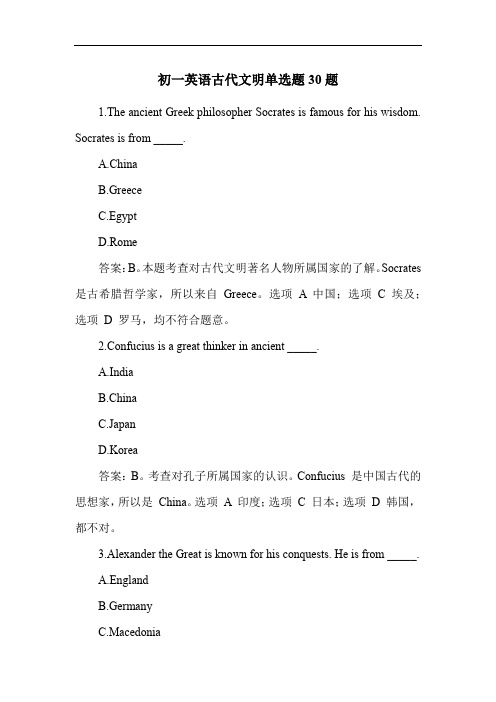
初一英语古代文明单选题30题1.The ancient Greek philosopher Socrates is famous for his wisdom. Socrates is from _____.A.ChinaB.GreeceC.EgyptD.Rome答案:B。
本题考查对古代文明著名人物所属国家的了解。
Socrates 是古希腊哲学家,所以来自Greece。
选项 A 中国;选项 C 埃及;选项D 罗马,均不符合题意。
2.Confucius is a great thinker in ancient _____.A.IndiaB.ChinaC.JapanD.Korea答案:B。
考查对孔子所属国家的认识。
Confucius 是中国古代的思想家,所以是China。
选项A 印度;选项C 日本;选项D 韩国,都不对。
3.Alexander the Great is known for his conquests. He is from _____.A.EnglandB.GermanyC.MacedoniaD.France答案:C。
Alexander the Great 来自马其顿,即Macedonia。
选项A 英国;选项B 德国;选项D 法国,都不是他的国家。
4.The Egyptian pharaohs ruled over _____.A.EgyptB.IndiaC.GreeceD.China答案:A。
埃及法老统治的是埃及,即Egypt。
选项B 印度;选项C 希腊;选项D 中国,均错误。
5.The Roman emperor Caesar is from _____.A.RomeB.ChinaC.GreeceD.Egypt答案:A。
Caesar 是罗马皇帝,来自Rome。
选项B 中国;选项C 希腊;选项D 埃及,不符合。
6.The Great Pyramid is in _____.A.EgyptB.ChinaC.GreeceD.Rome答案:A。
四大文明古国英语
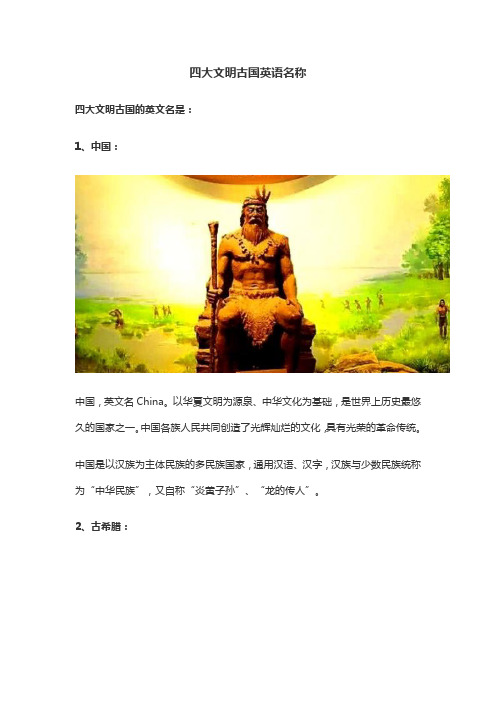
四大文明古国英语名称
四大文明古国的英文名是:
1、中国:
中国,英文名China。
以华夏文明为源泉、中华文化为基础,是世界上历史最悠久的国家之一。
中国各族人民共同创造了光辉灿烂的文化,具有光荣的革命传统。
中国是以汉族为主体民族的多民族国家,通用汉语、汉字,汉族与少数民族统称为“中华民族”,又自称“炎黄子孙”、“龙的传人”。
2、古希腊:
古希腊,英文名Ancient Greece。
是西方文明的源头之一,古希腊文明持续了约650年,是西方文明最重要和直接的渊源。
西方有记载的文学、科技、艺术都是从古代希腊开始的。
古希腊不是一个国家的概念,而是一个地区的称谓。
古希腊位于欧洲的东南部、地中海的东北部,包括希腊半岛、爱琴海和爱奥尼亚海上的群岛和岛屿、土耳其西南沿岸、意大利东部和西西里岛东部沿岸地区。
3、古印度:
古印度,英文名Ancient India。
地域范围包括今印度、巴基斯坦等国。
印度是一个文化的大熔炉,这个国家独特的历史背景使得它包含了从远古到现代、从西方到东方、从亚洲到欧洲等多种文化潮流。
再加上它是一个由五大民族构成的国家,本身就像一个大大的文化博物馆。
4、古埃及:
古埃及,英文名Ancient Egypt。
是四大文明古国之一。
位于非洲东北部尼罗河中下游,距今约740多年前,阿拉伯帝国将其伊斯兰化。
古埃及王国先后历经了:前王朝、早王朝、古王国、第一中间期、中王国、第二中间期、新王国、第三中间期、晚王国、托勒密王朝,共10个时期,33个王朝的统治。
Introduction to Ancient India - 古印度简介

古印度文明的发展历程
添加标题
起源:公元前2600年左右,印度河流域出现城市,哈拉 帕和摩亨佐达罗。
添加标题
吠陀时代:公元前2000年至公元前1000年,印度进入吠 陀时代,种姓制度开始形成。
添加标题
列国时代:公元前6世纪,印度进入列国时代,佛教和耆 那教兴起。
添加标题
孔雀王朝:公元前320年至公元前185年,印度进入孔雀 王朝时期,阿育王统一印度,佛教成为国教。
叹为观止。
古印度建筑注 重细节,雕刻 精美,展现出 古印度人民的 创造力和艺术
天赋。
古印度建筑在 材料和结构方 面也有许多创 新,如采用砖 石、拱门和穹 顶等建筑技术。
古印度的雕塑艺术
起源:公元前 3000年左右,印 度河流域文明时期
特点:形式多样, 内容丰富,包括动 物、人物等
材质:多为石材, 如砂石、大理石等
古印度语言的特征和影响
语言:梵语、吠陀经等 文字:婆罗米字母、天城体等 特征:语法复杂、词汇丰富、表达细腻 影响:对世界语言和文学产生了深远的影响,如瑜伽、佛教等
古印度语言与文化的传承
古印度拥有多种 语言,包括梵语、 巴利语和马拉地 语等。
古印度语言对世 界语言和文学产 生了深远影响, 如对英语、阿拉 伯语和汉语等语 言的影响。
古印度对世界科技和经济的影响
数学:发明阿拉伯数字和十进制 天文学:制定日历,预测天文现象 医学:传统医学体系阿育吠陀和悉达 科技:发明轮子和风帆
古印度的社会与政治制度
第五章
古印度的社会结构
种姓制度:古印度社会的主要特征,分为婆罗门、刹帝利、吠舍和首陀罗四个种姓
社会等级:种姓制度决定了人们在社会中的地位和权利,不同种姓之间存在严格的界限
印度文化介绍英文作文

印度文化介绍英文作文英文:India is a country with a rich and diverse culture. There are many different languages spoken throughout the country, and each region has its own unique traditions and customs. One of the most well-known aspects of Indian culture is its food. Indian cuisine is famous for its use of spices and flavors, and it varies greatly from region to region. For example, in the north, you might find dishes like butter chicken and naan bread, while in the south, you might find dishes like dosa and sambar.Another important aspect of Indian culture is religion. India is home to many different religions, including Hinduism, Islam, Christianity, and Sikhism. Each religion has its own set of beliefs and practices, and they all coexist peacefully in India. For example, during the Hindu festival of Diwali, people light lamps and decorate their homes with colorful lights to celebrate the victory oflight over darkness.Music and dance are also an integral part of Indian culture. Classical Indian dance forms like Bharatanatyamand Kathak are known for their intricate footwork and hand gestures, while Bollywood dance is known for its high-energy moves and catchy music. Indian music is also diverse, with different styles of music like classical, folk, and Bollywood.中文:印度是一个文化丰富多彩的国家。
Unit 5 第三课时Reading and Thinking 高一英语(人教版2019必修第一册)
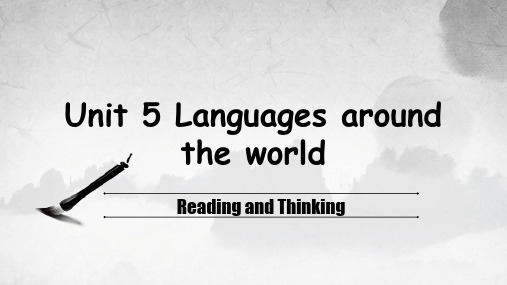
Viewing
Activity 5 Critical Thinking
Chinese writing system is one factor that has helped the Chinese civilization survive. Work in groups, and find out what you think are some of the other factors.
Para. 4
unification in the Qin Dynasty
Para. 5 art form--calligraphy
Para. 6 Influence & importance
Activity 3 Scanning for details
1.Scan the text to find the words or phrases that describe a time. (from para2-para6) 2.What happened at each of the important times?
ttoo tahne sswurevrivwalhaennd
expected
dCehwvinreaieltrositepnicmgclueetl?nthuteroef.
information?
Activity 5 Critical Thinking Chinese writing system is one factor that has helped the Chinese civilization survive.
ancient China
初一英语古代文明练习题40题答案解析版
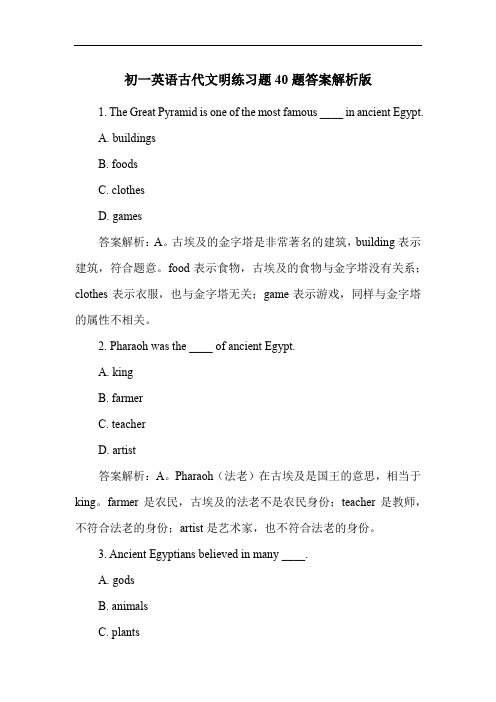
初一英语古代文明练习题40题答案解析版1. The Great Pyramid is one of the most famous ____ in ancient Egypt.A. buildingsB. foodsC. clothesD. games答案解析:A。
古埃及的金字塔是非常著名的建筑,building表示建筑,符合题意。
food表示食物,古埃及的食物与金字塔没有关系;clothes表示衣服,也与金字塔无关;game表示游戏,同样与金字塔的属性不相关。
2. Pharaoh was the ____ of ancient Egypt.A. kingB. farmerC. teacherD. artist答案解析:A。
Pharaoh(法老)在古埃及是国王的意思,相当于king。
farmer是农民,古埃及的法老不是农民身份;teacher是教师,不符合法老的身份;artist是艺术家,也不符合法老的身份。
3. Ancient Egyptians believed in many ____.A. godsB. animalsC. plants答案解析:A。
古埃及人信仰很多神,god在这里表示神。
虽然古埃及人对某些动物、植物和河流有特殊情感,但这里说的是信仰方面,主要是信仰神。
4. The Sphinx in Egypt has the body of a ____.A. lionB. horseC. dogD. cat答案解析:A。
埃及的狮身人面像(The Sphinx)身体是狮子的身体。
horse是马,dog是狗,cat是猫,都不符合狮身人面像的特征。
5. Ancient Egyptians used ____ to write.A. paperB. papyrusC. stoneD. wood答案解析:B。
古埃及人使用纸莎草(papyrus)来书写,而不是现代意义的paper(纸张),stone是石头,wood是木头,都不是古埃及书写的主要材料。
古印度文明
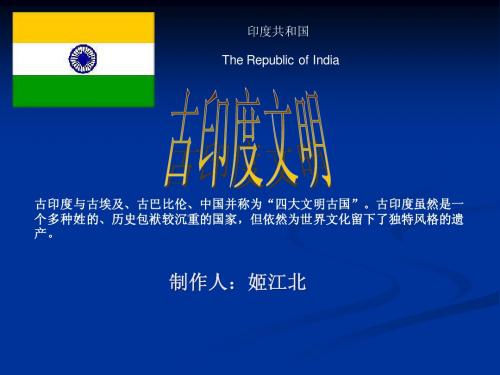
语言
印度的语系主要有印欧语系、汉藏语系、南亚语 系、德拉维达语系,语言复杂。目前印度的官方语 言是印地语,约30%人口使用;英语已经在1965年 终止了它唯一官方语言(或与印地语相同的)的地 位,但依旧保留了它“第二附加官方语言”的地位, 亦是全国性的通用语言,主要在政治和商业交往场 合使用。另外还有其他21种地方性的预定官方语言。
瞧,这就是印度的泰姬陵。
坐落于印度古都阿格的泰姬陵,是世界七大奇迹之一。 17世纪莫卧儿帝国皇帝沙杰汉为纪念其爱妃 坐落于印度古都阿格的泰姬陵,是世界七大奇迹之一。 17世纪莫卧儿帝国皇帝沙杰汉为纪念其爱妃 慕塔芝玛,动用了数万名工人,以宝石镶饰修建陵寝,图案之细致令人叫绝。 泰姬陵宏伟壮观, 慕塔芝玛,动用了数万名工人,以宝石镶饰修建陵寝,图案之细致令人叫绝。 泰姬陵宏伟壮观,以纯 白大理石砌建而成的主体建筑直叫人心醉神迷, 白大理石砌建而成的主体建筑直叫人心醉神迷,四 座长长的尖塔、皇陵前方的清澈水道、偌大的花园,使它盛名响遍环宇。 座长长的尖塔、皇陵前方的清澈水道、偌大的花园,使它盛名响遍环宇。 泰姬陵最引人瞩目的是用纯 白大理石砌建而成的主体建筑,皇陵上下左右工整对称,中央圆顶高六十二米,令人叹为观止。 白大理石砌建而成的主体建筑,皇陵上下左右工整对称,中央圆顶高六十二米,令人叹为观止。
饮食
印度人的日常饮食,南北方有很大差别。北方人以 小麦、玉米、豆类等为主食,尤其喜欢吃一种叫做 “恰巴提”的薄面饼。南方和东部沿海地区的人们 以大米为主食,爱吃炒饭。而中部德干高原则以小 米和杂粮为主。印度人喜欢吃带有辣味的、伴有咖 喱的食物。
印亚关系
• 印度同东南亚国家地理位置相近,有悠久的历史关系,但因印19701990年间外交上推行亲苏政策及双方在柬埔寨问题上存在分歧,印与 东南亚国家政治关系一般。九十年代,印积极推行东向政策,重视加 强同东盟各成员国的交流与合作。
古印度文化【英文】 Great Ancient Indians
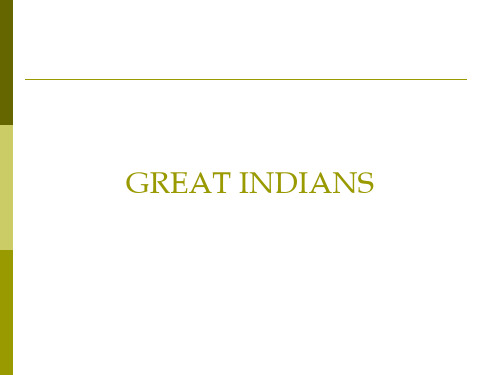
ACHARYA SUSHRUTA (600 BCE) FATHER OF PLASTIC SURGERY
ACHARYA SUSHRUTA
Biblioteka A genius who has been glowingly recognized in the annals of medical science. Born to sage Vishwamitra, Acharya Sudhruta details the first ever surgery procedures in "Sushruta Samhita," a unique encyclopedia of surgery. He is venerated as the father of plastic surgery and the science of anesthesia. When surgery was in its infancy in Europe, Sushruta was performing Rhinoplasty (restoration of a damaged nose) and other challenging operations. In the "Sushruta Samhita," he prescribes treatment for twelve types of fractures and six types of dislocations. His details on human embryology are simply amazing. Sushruta used 125 types of surgical instruments including scalpels, lancets, needles, Cathers and rectal speculums; mostly designed from the jaws of animals and birds. He has also described a number of stitching methods; the use of horse's hair as thread and fibers of bark. In the "Sushruta Samhita," and fibers of bark. In the "Sushruta Samhita," he details 300 types of operations. The ancient Indians were the pioneers in amputation, caesarian and cranial surgeries. Acharya Sushruta was a giant in the arena of medical science.
古印度历史文化介绍大全
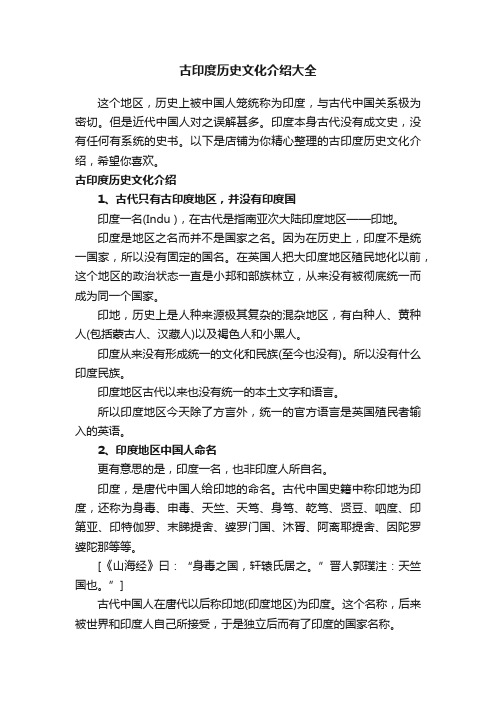
古印度历史文化介绍大全这个地区,历史上被中国人笼统称为印度,与古代中国关系极为密切。
但是近代中国人对之误解甚多。
印度本身古代没有成文史,没有任何有系统的史书。
以下是店铺为你精心整理的古印度历史文化介绍,希望你喜欢。
古印度历史文化介绍1、古代只有古印度地区,并没有印度国印度一名(Indu ),在古代是指南亚次大陆印度地区——印地。
印度是地区之名而并不是国家之名。
因为在历史上,印度不是统一国家,所以没有固定的国名。
在英国人把大印度地区殖民地化以前,这个地区的政治状态一直是小邦和部族林立,从来没有被彻底统一而成为同一个国家。
印地,历史上是人种来源极其复杂的混杂地区,有白种人、黄种人(包括蒙古人、汉藏人)以及褐色人和小黑人。
印度从来没有形成统一的文化和民族(至今也没有)。
所以没有什么印度民族。
印度地区古代以来也没有统一的本土文字和语言。
所以印度地区今天除了方言外,统一的官方语言是英国殖民者输入的英语。
2、印度地区中国人命名更有意思的是,印度一名,也非印度人所自名。
印度,是唐代中国人给印地的命名。
古代中国史籍中称印地为印度,还称为身毒、申毒、天竺、天笃、身笃、乾笃、贤豆、呬度、印第亚、印特伽罗、末睇提舍、婆罗门国、沐胥、阿离耶提舍、因陀罗婆陀那等等。
[《山海经》曰:“身毒之国,轩辕氏居之。
”晋人郭璞注:天竺国也。
”]古代中国人在唐代以后称印地(印度地区)为印度。
这个名称,后来被世界和印度人自己所接受,于是独立后而有了印度的国家名称。
【印度这个名称是唐僧玄奘《大唐西域记》正式命名的。
书中描述古印度曰:“详夫天竺之称,异议纠纷,旧云身毒,或曰贤豆,今从正音,宜云印度。
印度之人,随地称国,殊方异俗,遥举总名,语其所美,谓之印度。
印度者,唐言“月”。
月(在印地方言中)有多名,斯其一称。
言诸群生轮回不息,无明长夜莫有司晨,其犹白日既隐,宵月斯继,虽有星光之照,岂如朗月之明!敬缘斯致,因而譬月。
良以其土圣贤继轨,导凡御物,如月照临。
- 1、下载文档前请自行甄别文档内容的完整性,平台不提供额外的编辑、内容补充、找答案等附加服务。
- 2、"仅部分预览"的文档,不可在线预览部分如存在完整性等问题,可反馈申请退款(可完整预览的文档不适用该条件!)。
- 3、如文档侵犯您的权益,请联系客服反馈,我们会尽快为您处理(人工客服工作时间:9:00-18:30)。
NAGARJUNA (100 CE) WIZARD OF CHEMICAL SCIENCE
NAGARJUNA
ห้องสมุดไป่ตู้
He was an extraordinary wizard of science born in the nondescript village of Baluka in Madhya Pradesh. His dedicated research for twelve years produced maiden discoveries and inventions in the faculties of chemistry and metallurgy. Textual masterpieces like "Rasa Ratnakara“, "Rashrudaya" and "Rasendramangala" are his renowned contributions to the science of chemistry. Where the medieval alchemists of England failed, Nagarjuna had discovered the alchemy of transmuting base metals into gold. As the author of medical books like "Arogyamanjari" and "Yogasara" he also made significant contributions to the field of curative medicine. Because of his profound scholarliness and versatile knowledge, he was appointed as Chancellor of the famous University of Nalanda. Nagarjuna's milestone discoveries impress and astonish the scientists of today.
ACHARYA SUSHRUTA (600 BCE) FATHER OF PLASTIC SURGERY
ACHARYA SUSHRUTA
A genius who has been glowingly recognized in the annals of medical science. Born to sage Vishwamitra, Acharya Sudhruta details the first ever surgery procedures in "Sushruta Samhita," a unique encyclopedia of surgery. He is venerated as the father of plastic surgery and the science of anesthesia. When surgery was in its infancy in Europe, Sushruta was performing Rhinoplasty (restoration of a damaged nose) and other challenging operations. In the "Sushruta Samhita," he prescribes treatment for twelve types of fractures and six types of dislocations. His details on human embryology are simply amazing. Sushruta used 125 types of surgical instruments including scalpels, lancets, needles, Cathers and rectal speculums; mostly designed from the jaws of animals and birds. He has also described a number of stitching methods; the use of horse's hair as thread and fibers of bark. In the "Sushruta Samhita," and fibers of bark. In the "Sushruta Samhita," he details 300 types of operations. The ancient Indians were the pioneers in amputation, caesarian and cranial surgeries. Acharya Sushruta was a giant in the arena of medical science.
ACHARYA KANADA (600 BCE) FOUNDER OF ATOMIC THEORY
ACHARYA KANADA
As the founder of "Vaisheshika Darshana"- one of six principal philosophies of India - Acharya Kanada was a genius in philosophy. He is believed to have been born in Prabhasa Kshetra near Dwarika in Gujarat. He was the pioneer expounder of realism, law of causation and the atomic theory. He has classified all the objects of creation into nine elements, namely: earth, water, light, wind, ether, time, space, mind and soul. He says, "Every object of creation is made of atoms which in turn connect with each other to form molecules“. His statement ushered in the Atomic Theory for the first time ever in the world, nearly 2500 years before John Dalton. Kanada has also described the dimension and motion of atoms and their chemical reactions with each other. The eminent historian, T.N. Colebrook, has said, "Compared to the scientists of Europe, Kanada and other Indian scientists were the global masters of this field."
BHASKARACHARYA II (1114-1183 CE) GENIUS IN ALGEBRA
BHASKARACHARYA II
Born in the obscure village of Vijjadit (Jalgaon) in Maharastra, Bhaskaracharya's work in Algebra, Arithmetic and Geometry catapulted him to fame and immortality. His renowned mathematical works called "Lilavati" and "Bijaganita" are considered to be unparalled and a memorial to his profound intelligence. Its translation in several languages of the world bear testimony to its eminence. In his treatise "Siddhanta Shiromani" he writes on planetary positions, eclipses, cosmography, mathematical techniques and astronomical equipment. In the "Surya Siddhanta" he makes a note on the force of gravity: "Objects fall on earth due to a force of attraction by the earth. Therefore, the earth, planets, constellations, moon, and sun are held in orbit due to this attraction“. Bhaskaracharya was the first to discover gravity, 500 years before Sir Isaac Newton. He was the champion among mathematicians of ancient and medieval India. His works fired the imagination of Persian and European scholars, who through research on his works earned fame and popularity.
